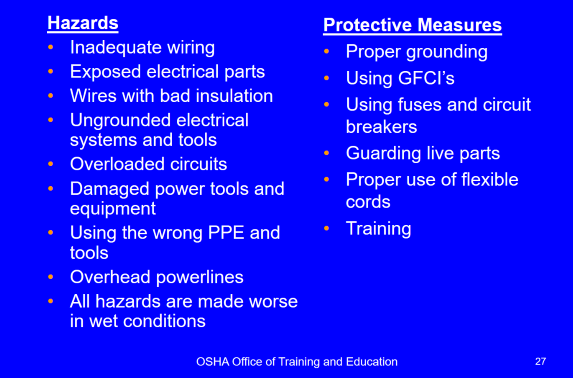Ignoring or not following safety rules can create serious issues concerning patient and employee safety, in addition to the potential for expensive penalties and legal issues. OSHA focuses on electrical safety during inspections for two important reasons:
According to OSHA, electrical accidents appear to be caused by a combination of the following three factors:
There are various ways of protecting people from the hazards caused by electricity. These include insulation, guarding, grounding, electrical protective devices, and safe work practices.

When OSHA is inspecting your practice, they will look for electrical violations and hazards. There are four types to keep in mind: water hazards, exposed wires, accident hazards, and emergency response problems.
Water Hazards
Any outlet close enough to water to be splashed must be protected by a Ground Fault Circuit Interrupter (GFCI). GFCIs will shut off the electric circuit if it detects a problem. A GFCI must be used on outlets that can potentially get wet from a water source. This includes all outlets in or near the following:
If you are running an extension cord by a water source, the outlet it is plugged into or the cord itself must have a GFCI. GFCI extension cords can be purchased at any home improvement store.
Exposed Wires
OSHA will assume that any exposed wire will be a hazard. They will look for and notice the following: broken or missing faceplates, holes in walls or ceilings, frayed cords, and breaker boxes with open areas. All circuits in breaker boxes should be labeled to prevent accidents. All unused circuits should be covered. All unused breaker switches should be labeled as such to prevent confusion.
Accident Hazards
Electrical wiring can create other hazards with misuse. Overloaded outlets, power strips and extension cords can easily cause fires. Wires and extension cords that run through traffic areas, even under carpet, will create trip hazards. Dangling cords, especially above water sources, could fall into water and cause electrical shock.
Household appliances like space heaters, fans, microwaves, and heating pads can be used in the office; but to ensure they are as safe as possible they must have a tag from a national testing laboratory. The device must also be in good working order with no loose or frayed cords. Fans should not be used in an area that could disperse aerosols containing germs, blood/bloody secretions, or other body fluids.
Emergency Response Problems
The time to find out about response problems is not when you are having an emergency! OSHA will check and verify avenues that you may not think about. Take time now to ensure you’re in compliance with the following rules:
Prioritizing electrical safety is not only a legal mandate but also an important component of ensuring patient care within healthcare facilities. By adhering to the OSHA guidelines, you can effectively mitigate the potential risks associated with electrical incidents. Recognizing the severity of electrical hazards is imperative, as emphasized by 12% of worker fatalities result from such incidents. Taking proactive measures and instilling a culture of vigilance regarding electrical safety is paramount in safeguarding both healthcare professionals and patients alike.

Total Medical Compliance
6124 Creft Circle
Indian Trail, NC 28079
Phone: (888) 862-6742
Fax: (866) 875-3809
©2023 Total Medical Compliance

Total Medical Compliance
6124 Creft Circle
Indian Trail, NC 28079
(888) 862-6742
Fax (866) 875-3809
©2022 Total Medical Compliance